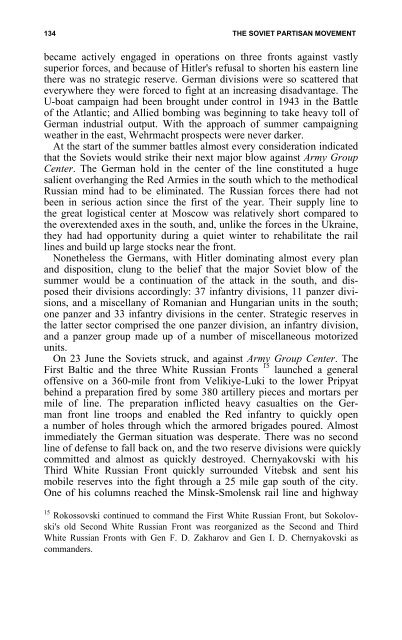the soviet partisan movement 1941-1944 by edgar m. howell
the soviet partisan movement 1941-1944 by edgar m. howell
the soviet partisan movement 1941-1944 by edgar m. howell
You also want an ePaper? Increase the reach of your titles
YUMPU automatically turns print PDFs into web optimized ePapers that Google loves.
134 THE SOVIET PARTISAN MOVEMENT<br />
became actively engaged in operations on three fronts against vastly<br />
superior forces, and because of Hitler's refusal to shorten his eastern line<br />
<strong>the</strong>re was no strategic reserve. German divisions were so scattered that<br />
everywhere <strong>the</strong>y were forced to fight at an increasing disadvantage. The<br />
U-boat campaign had been brought under control in 1943 in <strong>the</strong> Battle<br />
of <strong>the</strong> Atlantic; and Allied bombing was beginning to take heavy toll of<br />
German industrial output. With <strong>the</strong> approach of summer campaigning<br />
wea<strong>the</strong>r in <strong>the</strong> east, Wehrmacht prospects were never darker.<br />
At <strong>the</strong> start of <strong>the</strong> summer battles almost every consideration indicated<br />
that <strong>the</strong> Soviets would strike <strong>the</strong>ir next major blow against Army Group<br />
Center. The German hold in <strong>the</strong> center of <strong>the</strong> line constituted a huge<br />
salient overhanging <strong>the</strong> Red Armies in <strong>the</strong> south which to <strong>the</strong> methodical<br />
Russian mind had to be eliminated. The Russian forces <strong>the</strong>re had not<br />
been in serious action since <strong>the</strong> first of <strong>the</strong> year. Their supply line to<br />
<strong>the</strong> great logistical center at Moscow was relatively short compared to<br />
<strong>the</strong> overextended axes in <strong>the</strong> south, and, unlike <strong>the</strong> forces in <strong>the</strong> Ukraine,<br />
<strong>the</strong>y had had opportunity during a quiet winter to rehabilitate <strong>the</strong> rail<br />
lines and build up large stocks near <strong>the</strong> front.<br />
None<strong>the</strong>less <strong>the</strong> Germans, with Hitler dominating almost every plan<br />
and disposition, clung to <strong>the</strong> belief that <strong>the</strong> major Soviet blow of <strong>the</strong><br />
summer would be a continuation of <strong>the</strong> attack in <strong>the</strong> south, and disposed<br />
<strong>the</strong>ir divisions accordingly: 37 infantry divisions, 11 panzer divisions,<br />
and a miscellany of Romanian and Hungarian units in <strong>the</strong> south;<br />
one panzer and 33 infantry divisions in <strong>the</strong> center. Strategic reserves in<br />
<strong>the</strong> latter sector comprised <strong>the</strong> one panzer division, an infantry division,<br />
and a panzer group made up of a number of miscellaneous motorized<br />
units.<br />
On 23 June <strong>the</strong> Soviets struck, and against Army Group Center. The<br />
First Baltic and <strong>the</strong> three White Russian Fronts 15 launched a general<br />
offensive on a 360-mile front from Velikiye-Luki to <strong>the</strong> lower Pripyat<br />
behind a preparation fired <strong>by</strong> some 380 artillery pieces and mortars per<br />
mile of line. The preparation inflicted heavy casualties on <strong>the</strong> German<br />
front line troops and enabled <strong>the</strong> Red infantry to quickly open<br />
a number of holes through which <strong>the</strong> armored brigades poured. Almost<br />
immediately <strong>the</strong> German situation was desperate. There was no second<br />
line of defense to fall back on, and <strong>the</strong> two reserve divisions were quickly<br />
committed and almost as quickly destroyed. Chernyakovski with his<br />
Third White Russian Front quickly surrounded Vitebsk and sent his<br />
mobile reserves into <strong>the</strong> fight through a 25 mile gap south of <strong>the</strong> city.<br />
One of his columns reached <strong>the</strong> Minsk-Smolensk rail line and highway<br />
15 Rokossovski continued to command <strong>the</strong> First White Russian Front, but Sokolovski's<br />
old Second White Russian Front was reorganized as <strong>the</strong> Second and Third<br />
White Russian Fronts with Gen F. D. Zakharov and Gen I. D. Chernyakovski as<br />
commanders.
















